

Cable Nets and Grid Shells: Form-finding with GSA (Oasys Software Webinar) The focal geometry of circular and conical meshes. Abstract: Circular meshes are quadrilateral meshes all of whose faces possess a circumcircle, whereas conical meshes are planar quadrilateral meshes where the faces which meet in a vertex are tangent to a right circular cone.
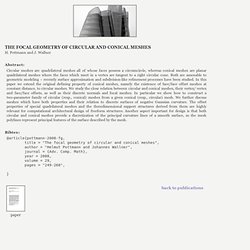
Both are amenable to geometric modeling – recently surface approximation and subdivision-like refinement processes have been studied. In this paper we extend the original defining property of conical meshes, namely the existence of face/face offset meshes at constant distance, to circular meshes. We study the close relation between circular and conical meshes, their vertex/ vertex and face/face offsets, as well as their discrete normals and focal meshes.
Kangaroo Physics. Example files. Edit 29/04/14 - Here is a new collection of more than 80 example files, organized by category: This zip is the most up to date collection of examples at the moment, and collects together a wide variety of definitions made for various workshops and in response to forum questions.
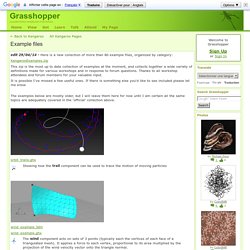
Thanks to all workshop attendees and forum members for your valuable input. It is possible I've missed a few useful ones. If there is something else you'd like to see included please let me know The examples below are mostly older, but I will leave them here for now until I am certain all the same topics are adequately covered in the 'official' collection above. Showing how the trail component can be used to trace the motion of moving particles The wind component acts on sets of 3 points (typically each the vertices of each face of a triangulated mesh). CurvePull - Pulls particles onto a curve. The Vortex component rotates one particle about an axis defined by 2 points. (also requires WeaverBird) drape_example.gh. Space Symmetry Structure. Kangaroo Physics. Project Kangaroo – Live 3D Physics for Rhino/Grasshopper – update. Here are some more videos of early tests of Kangaroo – the live physics engine for design modelling that I have recently started developing – and a bit more about its context and what it could be used for.
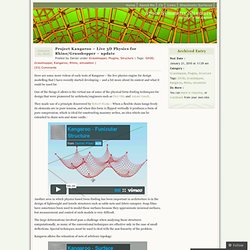
One of the things it allows is the virtual use of some of the physical form-finding techniques for design that were pioneered by architects/engineers such as Frei Otto and Antoni Gaudí. They made use of a principle discovered by Robert Hooke : When a flexible chain hangs freely its elements are in pure tension, and when this form is flipped vertically it produces a form of pure compression, which is ideal for constructing masonry arches, an idea which can be extended to chain nets and stone vaults : Another area in which physics based form-finding has been important in architecture is in the design of lightweight and tensile structures such as cable-nets and fabric canopies. Kangaroo allows the relaxation of nets of arbitrary topology: I believe that fun need not mean frivolous. Physics with Kangaroo (3 days) Recorded streaming.
Physics with Kangaroo. Physics and Form-Finding with Kangaroo NOW AVAILABLE IN RECORDED STREAMING!
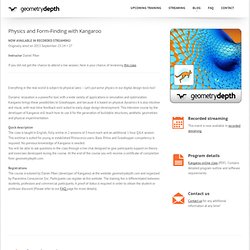
Originally aired on 2013 September 23-24 + 27 Instructor Daniel Piker If you did not get the chance to attend a live session, here is your chance of reviewing this class. Everything in the real world is subject to physical laws – Let’s put some physics in our digital design tools too! Kangaroo – Live 3D Physics for Rhino/Grasshopper. The live physics engine for design modelling.

Adaptive Structural Skins. Responsive Efficiency of Adaptive Structural Skins will explore how to form the load-bearing enclosure of a new generation of buildings through parametrization, analysis, optimization and form-finding.

In a world where the scale of human development has demonstrated its devastating effects on the natural environment and where imbalances in global economies have reduced opportunities for investment, efficiency in the use of natural and economic resources has become crucial in architectural practice. What if buildings could grow or shrink in size or change in shape to adapt to different programmatic or environmental requirements; what if they could be folded or rolled away to be easily transported and reused; what if this could be achieved through the engrained properties of the material they are made of, without the need for external energy or complex mechanical parts?
View Cluster Collaboration Site. Kangaroo - Mesh Relaxation - Tutorial 2. Vídeos de Daniel Piker. Kangaroo - Mesh Relaxation - Tutorial 1. Kangaroo - Mesh Relaxation - Tutorial 2. Kangaroo - Mesh Relaxation - Tutorial 3. Kangaroo. The Cloud at Burning Man So easily can fun and playfulness be neglected within Architecture.

My proposal stands as an embodiment of these aspects, creating an area of inclusive participation, a space that can be explored and is only complete when occupied. Fallen from the sky and tied down in the middle of Black Rock City ‘The Cloud’ stands as a mirage for weary-eyed travellers from far and wide, a beacon of sanctuary that creates spaces that provide respite from the harsh conditions of the desert using permeable fabric to create a cool atmosphere diffusing light within daylight and emitting a soft glow from within in the evening. Principle Stress Analysis Walking through the dessert after a long journey along the silk road ‘The Cloud’ emerges as a whimsical mirage.
The principle structure of the cloud is composed of hollow rolled steel tubes ,sandwiched between thick perforated fabric, strategically placed to withstand the extreme wind conditions as well as human interaction. Cadenary string modeller. Lecture Daniel Piker about architecture, based on physical laws. How to Create Planar Hexagons Using Planarization Forces. Space Symmetry Structure. Tensile Shading with Grasshopper + Kangaroo + Galapagos + Geco (Ecotect) Form Finding Experiment. Kangaroo basics. Kangaroo Physics.
Kangaroo Manual (Grasshopper version) Project Kangaroo – Live 3D Physics for Rhino/Grasshopper – update. Kangaroo - Mesh Relaxation - Tutorial 1. Kangaroo: Spring Force - Grasshopper. Kangaroo: Intro and Overview - Animation. Example files. Kangaroo. Yannis Chatzikonstantinou / Hoopsnake for Grasshopper. Update: Hoopsnake is now Opensource!

More info at Github HoopSnake, apart from a legendary creature, is a component for the Grasshopper™ 3D platform. What it does in principle is to create a copy of the data it receives at it's input upon user request and store it locally. This duplicate is made available through a standard Grasshopper parameter output. What this means in practice is that it is possible through the use of HoopSnake to send the output of a set of components back to it's input in a looping fashion. The loop can be stopped at any point either by the user or automatically by setting a termination condition (the third input of the component) to false. With the download file examples of various Hoopsnake configurations are included.
Licensed under a Creative Commons Attribution-NonCommercial-NoDerivs 3.0 Unported License. Please Note: I am currently unable to offer any assistance for Hoopsnake. BOLLINGER + GROHMANN. Kangaroo. Kangaroo. Grasshopper Magnetic Displacement. Here is a displacement by attractors definition for grasshopper based on some real physics: It allows you to set multiple ‘attractors’ which interact realistically just like electric charges, magnets, heat flows or ideal fluids.
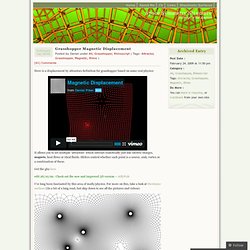
Sliders control whether each point is a source, sink, vortex or a combination of these. Get the ghx here edit 26/10/09 : Check out the new and improved 3D version – JellyFish. Space Symmetry Structure.